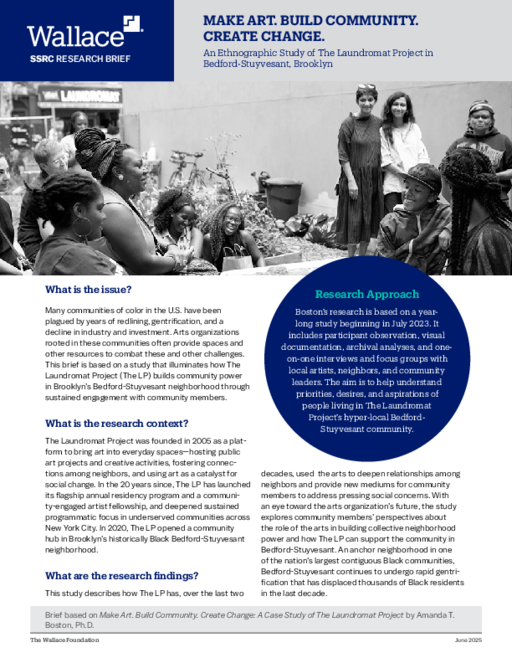Breadcrumb
- Wallace
- Reports
- Make Art. Build Community. Creat...
Make Art. Build Community. Create Change.
An ethnographic study of The Laundromat Project

- Publisher(s)
- The Wallace Foundation
Summary
Many communities of color in the U.S. have been plagued by years of redlining, gentrification, and a decline in investment. Arts organizations rooted in these communities often provide spaces and other resources to combat these challenges. In this study, researcher Amanda T. Boston illustrates how, over the last two decades, The Laundromat Project (The LP) has used the arts to deepen relationships among neighbors and provided new ways for community members to address pressing social concerns.
The LP was founded in 2005 as a way to bring art into everyday spaces. Its flagship annual residency program, Create Change, launched in 2006 and has supported artists and creatives to develop participatory and community-based creative projects in neighborhoods across New York City. Building on that work, The LP expanded its offerings to community gathering spaces and completed a strategic plan for sustained programming in the historically Black and Latinx neighborhoods of Bedford-Stuyvesant, Harlem, and the Hunts Point/Longwood section of the Bronx.
In 2020, after holding a series of listening sessions in Bedford-Stuyvesant, The LP secured a storefront on the neighborhood’s historic Fulton Street thoroughfare to serve as an anchor in the rapidly gentrifying community. Today, while The LP is active citywide, it operates with a hyper-local focus on sustained impact in Bedford-Stuyvesant through deep, community-responsive programming that uses arts and culture to strengthen social connections by bringing community members together for a wide range of events. The organization also helps cultivate local leaders through its programming and affirms what it calls “community power” by sharing resources with Bedford-Stuyvesant residents.
To better understand how it could continue to build community power, The LP and Boston asked local artists, neighbors, and community leaders to define what “power” meant to them. Community members stressed:
- The importance of collaboration and resource sharing
- A reverence for Black culture, and
- Love between individuals and within families and communities
Community members affirmed that the arts play a vital role in building community power through organizing and storytelling that encourages people to explore complex social issues. They also said art was important for bridge-building among Black people of different ethnicities. They also encouraged The LP to deepen its position as a contemporary community anchor, ready to meet the needs of local residents while continuing to be a critical resource in a community with rapidly rising rents and fewer Black-led spaces.
Why does this matter?
Arts organizations rooted in communities of color can be a key asset to their communities. They can help catalyze artmaking for social change, provide grassroots and creative leadership development, and serve as a knowledge and resource exchange. They may also become anchor institutions in communities undergoing profound residential, cultural, and political displacement.

The Laundromat Project was founded in 2005 as a platform to bring art into everyday spaces—hosting public art projects and creative activities, fostering connections among neighbors, and using art as a catalyst for social change.





